CCRN
Latest uploads at CCRN. Looking for notes at CCRN? We have lots of notes, study guides and study notes available for your school.
-
1400
- 0
-
76
All courses for CCRN
-
CCRN 1394
-
CCRN , 1
-
CCRN 1
-
CCRN! 2
Latest notes & summaries CCRN
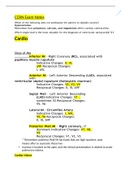
CCRN - CCRN Exam Notes. Questions with Answers. Complete A+ Solutions Guide.
- Exam (elaborations)
- • 77 pages's •
-
CCRN•CCRN
Preview 4 out of 77 pages
CCRN - CCRN Exam Notes. Questions with Answers. Complete A+ Solutions Guide.
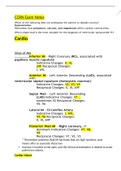
CCRN - CCRN Exam Notes. Questions with Answers. Complete A+ Solutions Guide. CCRN - CCRN Exam Notes. Questions with Answers. Complete A+ Solutions Guide.
- Exam (elaborations)
- • 77 pages's •
-
CCRN•CCRN
Preview 4 out of 77 pages
CCRN - CCRN Exam Notes. Questions with Answers. Complete A+ Solutions Guide. CCRN - CCRN Exam Notes. Questions with Answers. Complete A+ Solutions Guide.
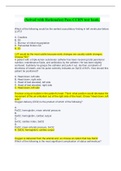
(Solved with Rationales) Pass CCRN test bank. Which of the following would be the earliest auscultatory finding in left ventricular failure (LVF)? A. Crackles B. S3 C. Murmur of mitral regurgitation D. Pericardial friction rub B. S3 LVF would be the most subtle because early changes are usually subtle changes. Choose "S3." A patient with a triple-lumen subclavian catheter has been receiving total parenteral nutrition, maintenance fluids, and antibiotics by the catheter. He has ...
- Package deal
- Exam (elaborations)
- • 47 pages's •
-
CCRN•CCRN
-
(Bundled Exams) PASS the CCRN! Distinction level test solutions (Updated 2022)• ByACADEMICAIDSTORE
Preview 4 out of 47 pages
(Solved with Rationales) Pass CCRN test bank. Which of the following would be the earliest auscultatory finding in left ventricular failure (LVF)? A. Crackles B. S3 C. Murmur of mitral regurgitation D. Pericardial friction rub B. S3 LVF would be the most subtle because early changes are usually subtle changes. Choose "S3." A patient with a triple-lumen subclavian catheter has been receiving total parenteral nutrition, maintenance fluids, and antibiotics by the catheter. He has ...
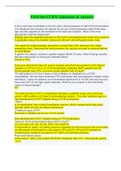
PASS the CCRN! Questions & Answers A 56 yr-old male is admitted to the ICU with a blood pressure of 225/135 and complains of a headache and nausea. He reports he ran out of blood pressure meds three days ago, but also appears to be confused to the date and situation. What is the most appropriate treatment approach? Rapidly lower the diastolic pressure to 100 with IV antihypertensive meds, then continue to gradually reduce the diastolic pressure to 85 with oral antihypertensive meds. The...
- Package deal
- Exam (elaborations)
- • 11 pages's •
-
CCRN•CCRN
-
(Bundled Exams) PASS the CCRN! Distinction level test solutions (Updated 2022)• ByACADEMICAIDSTORE
Preview 2 out of 11 pages
PASS the CCRN! Questions & Answers A 56 yr-old male is admitted to the ICU with a blood pressure of 225/135 and complains of a headache and nausea. He reports he ran out of blood pressure meds three days ago, but also appears to be confused to the date and situation. What is the most appropriate treatment approach? Rapidly lower the diastolic pressure to 100 with IV antihypertensive meds, then continue to gradually reduce the diastolic pressure to 85 with oral antihypertensive meds. The...
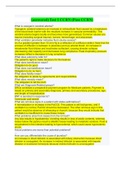
(answered) Test 1 CCRN (Pass CCRN) What is vasogenic cerebral edema? Vasogenic cerebral edema is an increase in extracellular fluid caused by a breakdown of the blood-brain barrier with the resultant increase in vascular permeability. This cerebral edema begins locally and becomes more generalized. Common causes are trauma (including surgical trauma), tumors, hemorrhage, and abscesses What ventilator parameter indicates fluid volume excess? An A:a gradient greater than 10 mm Hg is a reflec...
- Package deal
- Exam (elaborations)
- • 11 pages's •
-
CCRN•CCRN
-
(Bundled Exams) PASS the CCRN! Distinction level test solutions (Updated 2022)• ByACADEMICAIDSTORE
Preview 2 out of 11 pages
(answered) Test 1 CCRN (Pass CCRN) What is vasogenic cerebral edema? Vasogenic cerebral edema is an increase in extracellular fluid caused by a breakdown of the blood-brain barrier with the resultant increase in vascular permeability. This cerebral edema begins locally and becomes more generalized. Common causes are trauma (including surgical trauma), tumors, hemorrhage, and abscesses What ventilator parameter indicates fluid volume excess? An A:a gradient greater than 10 mm Hg is a reflec...
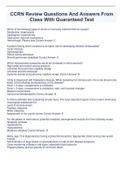
CCRN Review Questions And Answers From Class With Guaranteed Test
- Exam (elaborations)
- • 19 pages's •
-
CCRN•CCRN
Preview 3 out of 19 pages
CCRN Review Questions And Answers From Class With Guaranteed Test
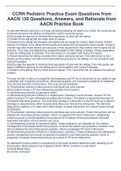
CCRN Pediatric Practice Exam Questions from AACN 150 Questions, Answers, and Rationale from AACN Practice Book
- Exam (elaborations)
- • 20 pages's •
-
CCRN•CCRN
Preview 3 out of 20 pages
CCRN Pediatric Practice Exam Questions from AACN 150 Questions, Answers, and Rationale from AACN Practice Book
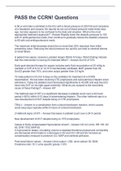
A 56 yr-old male is admitted to the ICU with a blood pressure of 225/135 and complains of a headache and nausea. He reports he ran out of blood pressure meds three days ago, but also appears to be confused to the date and situation. What is the most appropriate treatment approach? Rapidly lower the diastolic pressure to 100 with IV antihypertensive meds, then continue to gradually reduce the diastolic pressure to 85 with oral antihypertensive meds. The maximum initial decrease should be no m...
- Exam (elaborations)
- • 15 pages's •
-
CCRN•CCRN
Preview 2 out of 15 pages
A 56 yr-old male is admitted to the ICU with a blood pressure of 225/135 and complains of a headache and nausea. He reports he ran out of blood pressure meds three days ago, but also appears to be confused to the date and situation. What is the most appropriate treatment approach? Rapidly lower the diastolic pressure to 100 with IV antihypertensive meds, then continue to gradually reduce the diastolic pressure to 85 with oral antihypertensive meds. The maximum initial decrease should be no m...
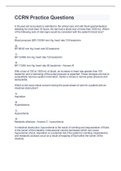
A 52-year-old accountant is admitted to the critical care unit with frank gastrointestinal bleeding for more than 18 hours. He has had a blood loss of more than 1000 mL. Which of the following sets of vital signs would be consistent with the patient's blood loss? A. Blood pressure (BP) 100/84 mm Hg, heart rate 124 beats/min B. BP 86/40 mm Hg, heart rate 92 beats/min C. BP 124/66 mm Hg, heart rate 124 beats/min D. BP 112/60 mm Hg, heart rate 92 beats/min A! With a loss of 750...
- Exam (elaborations)
- • 84 pages's •
-
CCRN•CCRN
Preview 4 out of 84 pages
A 52-year-old accountant is admitted to the critical care unit with frank gastrointestinal bleeding for more than 18 hours. He has had a blood loss of more than 1000 mL. Which of the following sets of vital signs would be consistent with the patient's blood loss? A. Blood pressure (BP) 100/84 mm Hg, heart rate 124 beats/min B. BP 86/40 mm Hg, heart rate 92 beats/min C. BP 124/66 mm Hg, heart rate 124 beats/min D. BP 112/60 mm Hg, heart rate 92 beats/min A! With a loss of 750...
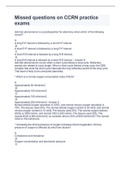
Ashman phenomenon is a predisposition for aberrancy when which of the following occurs? A. A long P-P interval is followed by a short P-P interval. B. A short P-P interval is followed by a long P-P interval. C. A short R-R interval is followed by a long R-R interval. D. A long R-R interval is followed by a short R-R interval. D Ashman phenomenon occurs when a short cycle follows a long cycle. Refractory periods are related to cycle length. When a short cycle follows a long cycle, the...
- Exam (elaborations)
- • 52 pages's •
-
CCRN•CCRN
Preview 4 out of 52 pages
Ashman phenomenon is a predisposition for aberrancy when which of the following occurs? A. A long P-P interval is followed by a short P-P interval. B. A short P-P interval is followed by a long P-P interval. C. A short R-R interval is followed by a long R-R interval. D. A long R-R interval is followed by a short R-R interval. D Ashman phenomenon occurs when a short cycle follows a long cycle. Refractory periods are related to cycle length. When a short cycle follows a long cycle, the...
